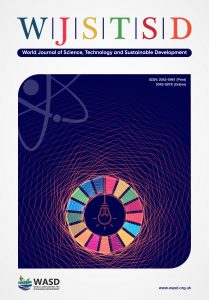Measuring the livelihood vulnerability index of a dry region in Indonesia: A case study of three subsistence communities in West Timor, Yenny Tjoe
 Yenny Tjoe
Yenny Tjoe
International Business and Asian Studies
Griffith University
Australia
Email: y.tjoe@griffith.edu.au
DOI: 10.1108/WJSTSD-01-2016-0013
Purpose: The purpose of this paper is to contribute to the study of sustainable rural livelihoods by developing a model to measure vulnerability of subsistence communities in dryland regions and identifying the major determinants that contribute to the livelihood vulnerability of these communities.
Design/methodology/approach: The author conducted a household survey across three subsistence communities in West Timor (n=627), from June to November 2013. Based on the guideline of the OECD (2008), the author developed a series of indicators and constructed a composite index to measure the vulnerability of dryland communities. The author adapted the livelihood vulnerability index (LVI) measure from Hahn et al. (2009) but refined it by using Shannon’s entropy method in deciding the weights of indicators and statistically tested the correlation between indicators using Kendall’s correlations.
Findings: Six major determinants were identified: education (EDU), children’s participation in agriculture (CPA), agricultural income (AI), subsistence food reserve (SUBSIST), social-cultural participation (SCP) and access to water, health clinic and market (ACC). LVI in all communities shows significant and strong relationships with SCP (0.594, p<0.01), AI (0.545, p<0.01) and CPA (0.434, p<0.01). This signifies that constraints to engage in social gatherings, market the harvest and obtain additional labour input are currently the major contributor to the vulnerability in these communities.
Research limitations/implications: Shannon' s entropy is one of the methods for assisting in making decision (ranking) objectively. The results may need to be tested further using other methods.
Practical implications: Using objective weight provides additional information useful for identifying and prioritising areas (sub-components) which require attention and appropriate solutions to prevent households from further impoverishment and increased vulnerability.
Social implications: Livelihood vulnerability of subsistence community in dry region is closely related to local survival skills and customs. Differences in the level of vulnerability across communities are due not only to geographical location and physical infrastructure, but also the leadership of local customary leaders and village government in looking for ways to improve the livelihoods of community members.
Originality/value: This paper is based on part of the results of a PhD thesis supported and approved by Griffith University. It has not been published before.
Keywords: Sustainability; Drylands; Climate change; Rural; Livelihood diversification; Subsistence community.
Citation: Tjoe, Y. (2016), "Measuring the livelihood vulnerability index of a dry region in Indonesia: A case study of three subsistence communities in West Timor", World Journal of Science, Technology and Sustainable Development, Vol. 13 No. 4, pp. 250-274. https://doi.org/10.1108/WJSTSD-01-2016-0013

